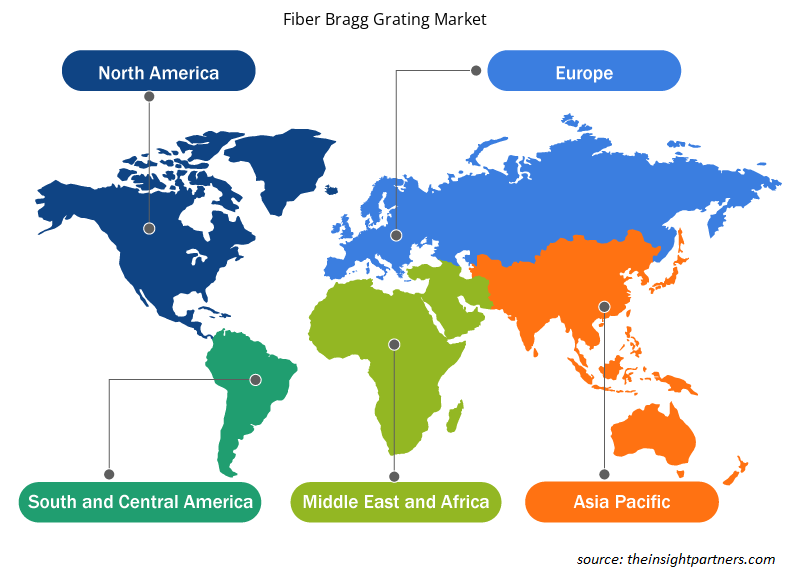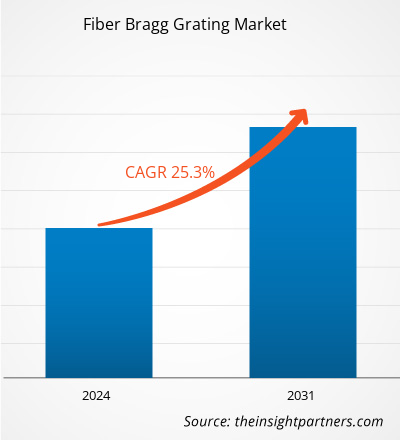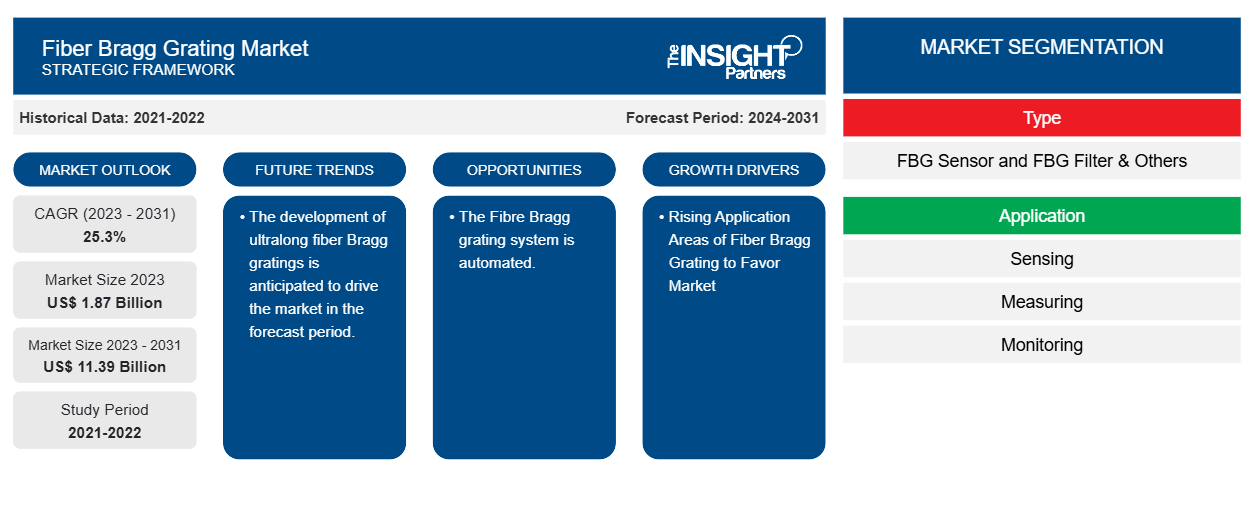Si prevede che la dimensione del mercato dei reticoli di Bragg in fibra raggiungerà 11,39 miliardi di dollari entro il 2031, rispetto ai 1,87 miliardi di dollari del 2023. Si prevede che il mercato registrerà un CAGR del 25,30% nel periodo 2023-2031. Le crescenti aree di applicazione dei reticoli di Bragg in fibra (FBG) e la crescente adozione degli FBG grazie ai loro vantaggi rimarranno probabilmente tendenze e driver chiave nel mercato.
Analisi di mercato dei reticoli di Bragg in fibra
Il mercato dei reticoli di Bragg in fibra sta vivendo una crescita significativa a livello globale. Questa crescita è attribuita alle crescenti aree di applicazione dei reticoli di Bragg in fibra (FBG) e alla crescente adozione di FBG grazie ai loro vantaggi. Inoltre, si prevede che l'implementazione di un sistema FBG automatizzato e lo sviluppo di reticoli di Bragg in fibra ultra-lunga offriranno diverse opportunità sul mercato.
Panoramica del mercato dei reticoli di Bragg in fibra
Un reticolo di Bragg in fibra (FBG) è una microstruttura solitamente lunga pochi millimetri che può essere fotoinscritta nel nucleo di una fibra monomodale. Ciò avviene illuminando trasversalmente la fibra con un raggio laser UV e utilizzando una maschera di fase per generare un pattern di interferenza nel suo nucleo. Ciò indurrà un cambiamento permanente nelle caratteristiche fisiche della matrice di silice.
Personalizza questo report in base alle tue esigenze
Riceverai la personalizzazione gratuita di qualsiasi report, comprese parti di questo report, o analisi a livello nazionale, pacchetto dati Excel, oltre a usufruire di grandi offerte e sconti per start-up e università
-
Scopri le principali tendenze di mercato in questo rapporto.Questo campione GRATUITO includerà analisi di dati che spaziano dalle tendenze di mercato alle stime e alle previsioni.
Driver e opportunità di mercato per i reticoli di Bragg in fibra
Crescenti campi di applicazione del reticolo di Bragg in fibra favoriranno il mercato.
Le crescenti aree di applicazione del reticolo di Bragg in fibra stanno guidando il mercato del reticolo di Bragg in fibra. Il reticolo di Bragg in fibra è utilizzato in settori quali telecomunicazioni, aerospaziale, energia e servizi di pubblica utilità, trasporti e altri. L'FBG è un elemento cruciale per le telecomunicazioni. Rispetto all'iscrizione UV di FBG in fibre di silice per applicazioni di telecomunicazioni, che si è sviluppata in un processo di produzione di massa standard e altamente riproducibile. Inoltre, il ruolo del reticolo di fase spaziale, che è una frequenza, è essenzialmente quello di formare un filtro o uno specchio a banda stretta (di trasmissione o riflessione) nel nucleo. Pertanto, considerando i parametri di cui sopra, l'aumento dell'area di applicazione del reticolo di Bragg in fibra sta guidando la crescita del mercato.
Il sistema di reticolo di Bragg in fibra è automatizzato.
Un FBG ha proprietà uniche per funzionare come sensore. I sensori a reticolo di Bragg in fibra (FBG) sono ampiamente utilizzati in varie applicazioni, tra cui l'automazione, grazie alle loro piccole dimensioni, all'elevata sensibilità e all'immunità alle interferenze elettromagnetiche. Questi sensori funzionano riflettendo particolari lunghezze d'onda della luce mentre ne trasmettono altre, dove la lunghezza d'onda riflessa cambia in risposta a cambiamenti di temperatura, sforzo o pressione. L'FBG è utilizzato in varie fasi dell'automazione identificando l'obiettivo di misurazione, selezionando i sensori FBG, l'integrazione con l'apparecchiatura, la connessione all'interrogatore ottico, la calibrazione e molto altro. Pertanto, considerando i vantaggi e le caratteristiche di cui sopra del reticolo di Bragg in fibra nell'automazione, si prevede che il mercato crescerà nei prossimi anni.
Analisi della segmentazione del rapporto di mercato del reticolo di Bragg in fibra
I segmenti chiave che hanno contribuito alla derivazione dell'analisi di mercato dei reticoli di Bragg in fibra sono tipologia, applicazione e settore.
- In base al tipo, il mercato dei reticoli di Bragg in fibra è suddiviso in sensore FBG e filtro FBG e altri. Si prevede che il segmento del sensore FBG detenga una quota di mercato significativa nel periodo di previsione.
- In base all'applicazione, il mercato dei reticoli di Bragg in fibra è suddiviso in rilevamento, misurazione, monitoraggio e altri. Si prevede che il segmento di rilevamento detenga una quota di mercato significativa nel periodo di previsione.
- Per settore, il mercato è segmentato in telecomunicazioni, aerospaziale, energia e servizi di pubblica utilità, trasporti e altri. Si prevede che le telecomunicazioni manterranno una quota di mercato significativa nel periodo di previsione.
Analisi della quota di mercato dei reticoli di Bragg in fibra per area geografica
L'ambito geografico del rapporto sul mercato dei reticoli di Bragg in fibra è suddiviso principalmente in cinque regioni: Nord America, Asia Pacifico, Europa, Medio Oriente e Africa, e Sud e Centro America.
Il Nord America ha dominato il mercato dei reticoli di Bragg in fibra. Il mercato del Nord America è suddiviso in Stati Uniti, Canada e Messico. Questa crescita è attribuita alle crescenti aree di applicazione dei reticoli di Bragg in fibra nella regione e alla crescente adozione di FBG grazie ai loro vantaggi. Inoltre, si prevede che l'implementazione di un sistema FBG automatizzato e lo sviluppo di reticoli di Bragg in fibra ultra-lunga offriranno diverse opportunità sul mercato. Inoltre, una forte enfasi sulla ricerca e sviluppo nelle economie sviluppate di Stati Uniti e Canada sta costringendo gli operatori nordamericani a portare sul mercato soluzioni tecnologicamente avanzate. Inoltre, gli Stati Uniti hanno un gran numero di operatori del mercato dei reticoli di Bragg in fibra che si sono sempre più concentrati sullo sviluppo di soluzioni innovative. Tutti questi fattori contribuiscono alla crescita del mercato dei reticoli di Bragg in fibra nella regione.
Approfondimenti regionali sul mercato dei reticoli di Bragg in fibra
Le tendenze regionali e i fattori che influenzano il Fiber Bragg Grating Market durante il periodo di previsione sono stati ampiamente spiegati dagli analisti di Insight Partners. Questa sezione discute anche i segmenti e la geografia del Fiber Bragg Grating Market in Nord America, Europa, Asia Pacifico, Medio Oriente e Africa e Sud e Centro America.

- Ottieni i dati specifici regionali per il mercato dei reticoli di Bragg in fibra
Ambito del rapporto di mercato del reticolo di Bragg in fibra
| Attributo del report | Dettagli |
|---|---|
| Dimensioni del mercato nel 2023 | 1,87 miliardi di dollari USA |
| Dimensioni del mercato entro il 2031 | 11,39 miliardi di dollari USA |
| CAGR globale (2023-2031) | 25,3% |
| Dati storici | 2021-2022 |
| Periodo di previsione | 2024-2031 |
| Segmenti coperti |
Per tipo
|
| Regioni e Paesi coperti |
America del Nord
|
| Leader di mercato e profili aziendali chiave |
|
Densità degli attori del mercato: comprendere il suo impatto sulle dinamiche aziendali
Il mercato del Fiber Bragg Grating Market sta crescendo rapidamente, spinto dalla crescente domanda degli utenti finali dovuta a fattori quali l'evoluzione delle preferenze dei consumatori, i progressi tecnologici e una maggiore consapevolezza dei vantaggi del prodotto. Con l'aumento della domanda, le aziende stanno ampliando le loro offerte, innovando per soddisfare le esigenze dei consumatori e capitalizzando sulle tendenze emergenti, il che alimenta ulteriormente la crescita del mercato.
La densità degli operatori di mercato si riferisce alla distribuzione di aziende o società che operano in un particolare mercato o settore. Indica quanti concorrenti (operatori di mercato) sono presenti in un dato spazio di mercato in relazione alle sue dimensioni o al valore di mercato totale.
Le principali aziende che operano nel mercato dei reticoli di Bragg in fibra sono:
- AOS GmbH
- Società di laboratori Alnair
- FBGS Tecnologie GmbH
- HBM Fibersensing SA
- Tecnologie ITF Inc.
- Fotonica Ixblue
Disclaimer : le aziende elencate sopra non sono classificate secondo un ordine particolare.

- Ottieni una panoramica dei principali attori del mercato dei reticoli di Bragg in fibra
Notizie di mercato e sviluppi recenti del reticolo di Bragg in fibra
Il mercato dei reticoli di Bragg in fibra viene valutato raccogliendo dati qualitativi e quantitativi dopo la ricerca primaria e secondaria, che include importanti pubblicazioni aziendali, dati di associazioni e database. Di seguito sono elencati alcuni degli sviluppi nel mercato dei reticoli di Bragg in fibra:
- TeraXion, uno dei leader della fotonica, ha lanciato una nuova gamma di filtri notch a reticolo di Bragg ad alta potenza, interamente in fibra. La serie WSF è composta da filtri band-stop (notch) interamente in fibra, utilizzati per attenuare o bloccare selettivamente una lunghezza d'onda o un intervallo di lunghezze d'onda, consentendo il passaggio di altre lunghezze d'onda. (Fonte: sito Web aziendale TeraXion, dicembre 2024)
Copertura e risultati del rapporto di mercato sui reticoli di Bragg in fibra
Il rapporto "Dimensioni e previsioni del mercato dei reticoli di Bragg in fibra (2021-2031)" fornisce un'analisi dettagliata del mercato che copre le seguenti aree:
- Dimensioni e previsioni del mercato dei reticoli di Bragg in fibra a livello globale, regionale e nazionale per tutti i principali segmenti di mercato coperti dall'ambito
- Tendenze del mercato dei reticoli di Bragg in fibra e dinamiche di mercato come driver, vincoli e opportunità chiave
- Analisi dettagliata delle cinque forze PEST/Porter e SWOT
- Analisi di mercato dei reticoli di Bragg in fibra che copre le principali tendenze del mercato, il quadro globale e regionale, i principali attori, le normative e i recenti sviluppi del mercato
- Analisi del panorama industriale e della concorrenza che copre la concentrazione del mercato, l'analisi della mappa di calore, i principali attori e gli sviluppi recenti per il mercato dei reticoli di Bragg in fibra
- Profili aziendali dettagliati
- Analisi storica (2 anni), anno base, previsione (7 anni) con CAGR
- Analisi PEST e SWOT
- Valore/volume delle dimensioni del mercato - Globale, Regionale, Nazionale
- Industria e panorama competitivo
- Set di dati Excel
Report recenti
Rapporti correlati
Testimonianze
Motivo dell'acquisto
- Processo decisionale informato
- Comprensione delle dinamiche di mercato
- Analisi competitiva
- Analisi dei clienti
- Previsioni di mercato
- Mitigazione del rischio
- Pianificazione strategica
- Giustificazione degli investimenti
- Identificazione dei mercati emergenti
- Miglioramento delle strategie di marketing
- Aumento dell'efficienza operativa
- Allineamento alle tendenze normative























 Ottieni un campione gratuito per - Mercato dei reticoli di Bragg in fibra
Ottieni un campione gratuito per - Mercato dei reticoli di Bragg in fibra